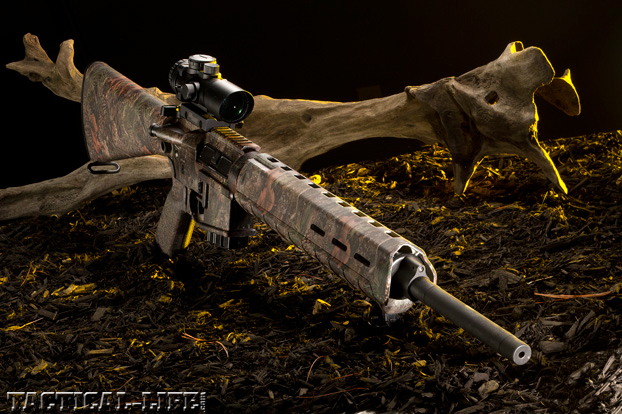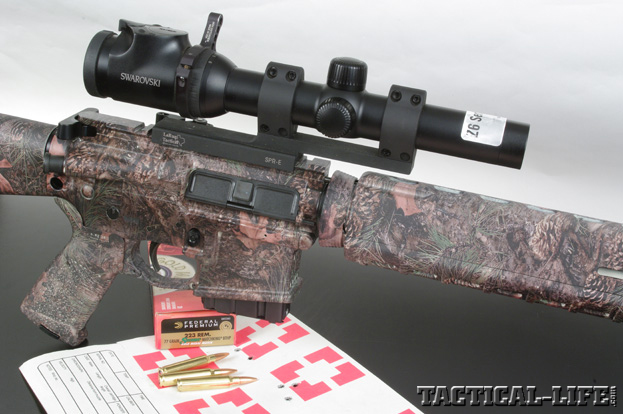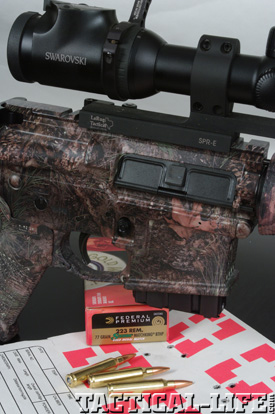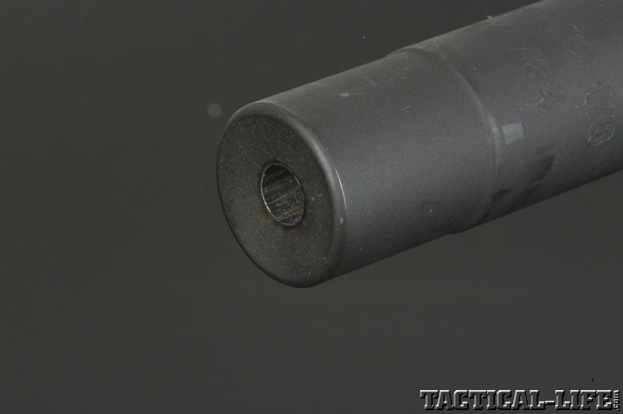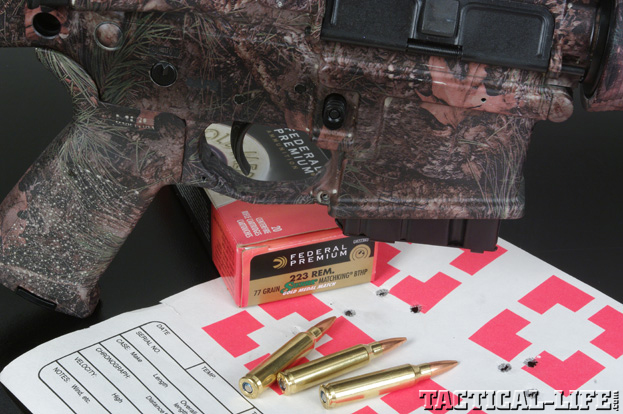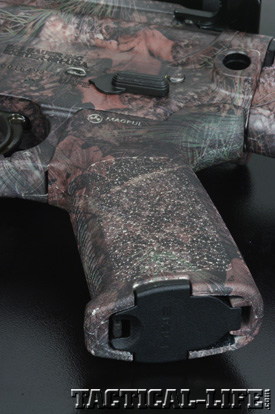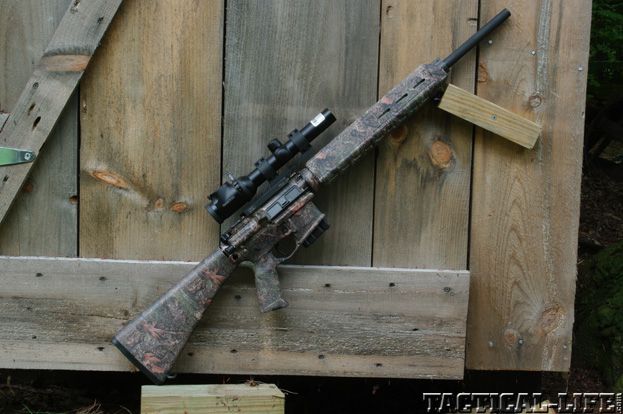When the hunting-with-AR-15s craze hit, I think a lot of manufacturers were caught off guard. In many circumstances the companies were not managed by hunters but by shooters who had a tactical background. They thought they could just put a camo coating on their guns and call them the hunting models, but they would have been better off talking to some gun-savvy hunters first.
Hunter Dedicated
The needs of a hunter are different than those of a shooter using an AR-15 for defensive purposes. While the AR-15 “platform” is well suited to some kinds of hunting, a few design features on the guns should be different. One place that the AR-15 rifle shines is in predator hunting. But we don’t need a flash suppressor for coyote hunting, at least not until the coyotes start shooting back. (The suppressor’s concept is to hide the primary flash from the enemy, so it’s totally useless for coyote hunting.) A muzzle brake is also unneeded, as its recoil mitigation is designed to speed up the following shots. Its job is to help a fast double-tap. Coyote hunters aren’t doing .12-split-time follow-up shots like competition shooters, and nobody double-taps a coyote. Besides, a brake makes the gun too loud to fire without hearing protection.
What coyote hunters need is velocity. The extra 2 inches of length used for a brake or flash suppressor would be better served as a longer bore for more muzzle velocity. The .223 Remington is a great cartridge, but when it comes to shooting coyotes it borders on marginal. I have had more coyotes get up and run off after being shot with a .223 than with any other cartridge, but hit them with the exact same bullet from a .22-250 or a .220 Swift and the percentage of coyotes lost after being hit drops dramatically. The difference? Velocity. Velocity is the magic ingredient in any predator cartridge used for coyote hunting. The .223 Remington struggles for enough velocity from any rifle, but the muzzle-velocity loss from a 16-inch barrel is just adding insult to injury. Hunters don’t need a camo’ed-up, 16-inch M4 with a birdcage flash suppressor. What a predator hunter needs from an AR-15 rifle is barrel length. When Sig Sauer decided to make a hunter version of the M400 Hunter rifle, somebody there must have known this.
Advertisement — Continue Reading Below
Specifications
The M400 Hunter comes without a threaded muzzle. The barrel is 20 inches, phosphate-coated, match grade and has a 1-in-8-inch twist rate with six grooves. The resulting rifle has a 38.5-inch overall length, which is still short enough to handle very well while the barrel is long enough to extract a bit more velocity from the cartridge. That’s a very good first step to building a predator-hunting AR-15.
The barrel is moderately heavy and tapers quickly from 0.98 inches at the chamber to 0.875 in front of the chamber. At the gas block it steps down to 0.765 inches. An inch in front of the block, it steps down again to 0.73 inches. Starting three-quarters of an inch from the muzzle, it steps down again to 0.715 inches. I am not sure why all these steps are in there, but I assume it’s for aesthetics and perhaps a bit of weight reduction. The barrel is finished with a coned, target-style crown. The M400 Hunter is chambered for the 5.56mm NATO round. This chamber design allows the use of any .223 Remington or 5.56mm ammunition. But the reverse is not true: you should never shoot 5.56mm ammo in a .223 Remington chamber.
Typically, the downside of a 5.56mm chamber is a slight loss of accuracy. The 5.56 chamber is slightly larger than the .223 Remington’s in just about every dimension. The primary difference is throat length, which can have a dramatic effect on pressure. The 5.56mm has a longer throat in the chamber than the .223 Remington. The throat is also commonly called the leade, which is defined as a portion of the barrel directly in front of the chamber where the rifling has been conically removed to allow room for the seated bullet. Leade in a .223 Remington chamber is usually .085 inches. In a 5.56mm chamber the leade is typically 0.162 inches, almost twice as much as the .223 Remington’s. The trouble is that a longer jump for the bullet to reach the rifling usually results in a bit less accuracy. In most cases the accuracy is still very good—more than acceptable for hunting. In this case the issue is moot, as the Sig Sauer M400 Hunter proved to be a very accurate rifle during my shooting tests.
Another thing that no varmint hunter needs is an A2 gas block with that giant front sight. We use scopes. Sig again got it right with a low-profile gas block. The only thing a varmint hunter needs a gas block to do is direct gas back to the action to cycle the rifle. That’s what this one does. One thing I would have preferred to see on this rifle is a floating forend tube. I think they make the rifle more accurate because the barrel is free-floating. Although, again, the gun shoots so well it’s hard to sustain my argument.
The M400 Hunter uses the Magpul MOE forend. This is a classic attachment design using a capture ring behind the gas block and a delta-ring lockup in back. The forend is made of two pieces of coarse metal with overmolded plastic on top. The lower is plastic with a metal insert held on with screws. This insert slides around the barrel to shield the forend from heat. The forend is well vented to allow the barrel to stay cooler during sustained fire, such as a hunter might encounter during a prairie-dog shoot. There is a detachable sling swivel stud on the front end.
Advertisement — Continue Reading Below
There are no rails on the forend, yet in states where it is legal to do so, a gun-mounted light would be a good addition for night hunting predators, wild boar and the like. The Magpul has slots at the 2, 6 and 10 o’clock positions, allowing the attachment of optional Picatinny rail sections, which can be used to mount light or other accessories. Recent experiences with night shooting tell me that a laser sight might be worth considering for night hunting. I am amazed at how well they work when shooting targets, and I can’t see why that wouldn’t be the case with coyotes as well. I intend to put my beliefs to the field-test on my next night predator mission.
Digging Deeper
Ergonomically, the forend is effectively designed and fits well in the hand for shooting. It has a wide base that settles properly in my palm and slightly tapering sides. It feels very secure in the hand. It is also wide enough to be stable on a sandbag if you decide to use the rifle for shooting prairie dogs. Anybody who has used a round forend on a sandbag knows the frustration that can result.
This is a direct-gas-impingement-operated gun, just as Stoner intended the AR-15 to be. The flattop-style upper receiver, of course, has a rail for mounting optics. I used a Swarovski 6-24×50 scope for accuracy testing but then swapped it with a Swarovski Z6 1-6 scope for coyote-hunting. The bolt and carrier are phosphate-coated black. The charging handle is standard without any extensions. One thing that is different from most AR rifles is that there is a pin protruding into the barrel extension, in position to support the extractor when the gun is in battery. This is a good idea to help prevent extractor failure.
Advertisement — Continue Reading Below
The upper receiver is fitted with a case deflector and a forward assist. Both of these are unnecessary on a hunting gun. They don’t hurt anything; they just add weight. The rifle weighs in at 7.8 pounds, which is not heavy by AR-15 standards. Still, when it comes to hunting rifles, my preference is to go light, so a bit of reduction might make those long days of hiking to calling stands seem a bit easier. The M400 Hunter was a fighting gun before it became a hunting gun, and my guess it that it is too expensive to tool up a new upper receiver for the hunting market.
That fighting heritage is shown further with the ambidextrous magazine release on the 7075-T6 aircraft-grade aluminum, forged lower receiver. In addition to the normal right-side mag-release button, the left side has a serrated pad that, when pushed, pivots and pulls the mag release open. With an ambi safety and a Magpul BAD bolt release, the rifle could be made fully ambidextrous, something the lefties should think about. The magazine releases on both sides are well protected by a fence on the lower receiver to prevent accidental release of the magazine. The bolt release and safety are pretty much standard, which is fine on a hunting gun. Except the safety is right-hand only, so lefties will have to deal with it or add an ambi safety. But if you are left-handed, you already knew that, as discrimination is rampant in firearms designs.
As for the rifle’s trigger, it breaks at 7.5 pounds. In my never-humble opinion I’d prefer a trigger in the 3- to 4-pound range for hunting purposes. But for certain, the 7.5-pound trigger has it’s place in law-enforcement and military circles.
Advertisement — Continue Reading Below
Both sides of the lower receiver have a pocket for a plunger-type sling attachment for a single-point sling. The triggerguard is oversized to allow easy trigger access while wearing gloves. The grip is a Magpul MOE with a trapdoor in the bottom so that the hollow center of this hard-plastic grip can be used for storage. The buttstock is a standard A2 design, which is excellent for hunting. Of course, it has the trapdoor in the butt for storing a cleaning kit and an attached sling swivel. One word of caution about these trapdoors: Make sure anything you put in them does not rattle. A coyote will hear that for a long way. If you store extra ammo or tools, wrap them in a cloth.
Ready To Hunt
The ergonomics of this rifle are very good. It feels comfortable and well balanced in the shooter’s hands. After some fairly extensive testing, the M400 Hunter has proven to be completely reliable with zero malfunctions or jams. Actually, that’s pretty rare in a new rifle. I find that most AR-15 rifles need a couple-hundred rounds though them before they mature enough to behave. This gun ran great right out of the box with a wide variety of ammo products.
The M400 Hunter is available in black or in Mixed Pine camouflage. The camo is applied by the dip method, which gives a clean, durable finish on all but the barrel, dustcover and controls. Other than maybe a drop-in trigger, which can only enhance its already impressive accuracy, this gun is ready to hunt out of the box. Just add ammo and optics. For more information, visit sigsauer.com or call 603-772-2302.
Advertisement — Continue Reading Below
